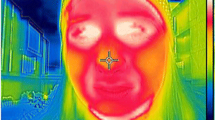Abstract
Wind chill equivalent temperatures (WCETs) were estimated by a modified Fiala’s whole body thermoregulation model of a clothed person. Facial convective heat exchange coefficients applied in the computations concurrently with environmental radiation effects were taken from a recently derived human-based correlation. Apart from these, the analysis followed the methodology used in the derivation of the currently used wind chill charts. WCET values are summarized by the following equation:
Results indicate consistently lower estimated facial skin temperatures and consequently higher WCETs than those listed in the literature and used by the North American weather services. Calculated dynamic facial skin temperatures were additionally applied in the estimation of probabilities for the occurrence of risks of frostbite. Predicted weather combinations for probabilities of “Practically no risk of frostbite for most people,” for less than 5 % risk at wind speeds above 40 km h−1, were shown to occur at air temperatures above −10 °C compared to the currently published air temperature of −15 °C. At air temperatures below −35 °C, the presently calculated weather combination of 40 km h−1/−35 °C, at which the transition for risks to incur a frostbite in less than 2 min, is less conservative than that published: 60 km h−1/−40 °C. The present results introduce a fundamentally improved scientific basis for estimating facial skin temperatures, wind chill temperatures and risk probabilities for frostbites over those currently practiced.





Similar content being viewed by others
References
Ben Shabat Y (2010) Modified wind chill temperature based on estimated human convective heat transfer coefficients and a whole body thermoregulation model. MSc thesis, Technion, Israel Institute of Technology, Haifa, Israel
Ben Shabat Y, Shitzer A (2012) Facial convective heat exchange coefficients in cold and windy environments estimated from human experiments. Int J Biometeorol 56:639–651
Bluestein M, Osczevski RJ (2002) The basis for the new wind chill temperature chart. 15th Conference on Biometeorology/Aerobiology and 16th International Congress of Biometeorology, Kansas City KS. Am Meteor Soc 2002:168–171
Brajkovic D, Ducharme MB (2004) Cheek skin temperature and thermal resistance in active and inactive individuals during exposure to cold wind. J Thermal Biol 29:831–837
Brauner N, Shacham M (1995) Meaningful wind chill indicators derived from heat transfer principles. Int J Biometeorol 39:46–52
Danielsson U (1996) Wind chill and the risk of tissue freezing. J Appl Physiol 81:2666–2673
Environment Canada Wind Chill Chart (2011) http://www.ohcow.on.ca/clinics/windsor/docs/workplaceconcernsseminars/windchillchart.pdf
Fiala D, Lomas KJ, Stohrer M (1999) A computer model of human thermoregulation for a wide range of environmental conditions: the passive system. J Appl Physiol 87(5):1957–1972
Fiala D, Lomas KJ, Stohrer M (2001) Computer predictions of human thermoregulatory and temperature responses to a wide range of environmental conditions. Int J Biometeorol 45:143–159
Fiala D, Havenith G, Bröde P, Kampmann B, Jendritzky G (2012) UTCI-Fiala multi-node model of human temperature regulation and thermal comfort. Int J Biometeorol 56(3):429–441
Havenith G, Fiala D, Blazejczyk K, Richards M, Bröde P, Holmér I, Rintamäki H, Benshabat Y, Jendritzky G (2012) The UTCI-Clothing model. Int J Biometeorol 56(3):461–470
Keatinge WR, Cannon P (1960) Freezing-point of human skin. Lancet 1:11–14
Knoblauch R, Nitzburg M, Dewar R, Templer J, Pietrucha M (1995) Older pedestrian characteristics for use in highway design. Office of Safety and Traffic Operations Research and Development, Federal Highway Administration, Pub FHWA-RD-93-177, 122 pp
Kreith F (1976) Principles of heat transfer, 3rd edn. Harper and Row, New York, pp 457–473
Kubaha K, Fiala D, Toftum J, Taki AH (2004) Human projected area factors for detailed direct and diffuse solar radiation analysis. Int J Biometeorol 49:113–129
NOAA’s National weather service (2009) http://www.weather.gov/os/windchill/index.shtml
OFCM (2003) Report on Wind Chill Temperature and Extreme Heat Indices: Evaluation and Improvement Projects. US Department of Commerce, National Oceanic and Atmospheric Administration, Office of the Federal Coordinator for Meteorological Services and Supporting Research, Repot No. FCM-R19-2003, Washington, DC
Osczevski RJ (1995) The basis of wind chill. Arctic 48(4):372–382
Osczevski R, Bluestein M (2005) The new wind chill equivalent temperatures chart. Bull Am Meteorol Soc 86:1453–1458
Pennes HH (1948) Analysis of tissue and arterial blood temperatures in the resting human arm. J Appl Physiol 1:93–122
Psikuta A, Fiala D, Laschewski G, Jendritzky G, Richards M, Błażejczyk K, Mekjavič I, Rintamäki H, de Dear R, Havenith G (2012) Validation of the Fiala multi-node thermophysiological model for UTCI application. Int J Biometeorol 56(3):443–460
Shitzer A (2006) Wind-chill-equivalent temperatures: regarding the impact due to the variability of the environmental convective heat transfer coefficient. Int J Biometeorol 50(4):224–232
Shitzer A (2007) Paradox: increased blood perfusion to the face enhances protection against frostbite while it lowers wind chill equivalent temperatures. Int J Biometeorol 51(5):383–393
Shitzer A, Tikuisis P (2012) Advances, shortcomings, and recommendations for wind chill estimation. Int J Biometeorol Special Issue (UTCI) Int J Biometeorol 56(3):495–503
Siple PA, Passel CF (1945) Measurements of dry atmospheric cooling in subfreezing temperatures. Proc Am Philos Soc 89(1):177–199
Steadman R (1971) Indices of windchill of clothed persons. J Appl Meteorol 10:674–683
Tikuisis P, Osczevski RJ (2002) Dynamic model of facial cooling. J Appl Meteorol 41(12):1241–1246
Tikuisis P, Osczevski RJ (2003) Facial cooling during cold air exposure. Am Meteorol Soc 84:927–933
Acknowledgments
The authors are indebted to Hannu Rintämaki, Ingvar Holmér and Peter Tikuisis for making their respective experimental data available for this study. Thanks are also due to Yoram Halevi for his inputs in the derivation of the WCET correlation. This work was initiated during the activities of Cost 730 Action of the European Cooperation in Scientific and Technical Research, on the development of the Universal Thermal Climate Index (UTCI).
Author information
Authors and Affiliations
Corresponding author
Rights and permissions
About this article
Cite this article
Shabat, Y.B., Shitzer, A. & Fiala, D. Modified wind chill temperatures determined by a whole body thermoregulation model and human-based facial convective coefficients. Int J Biometeorol 58, 1007–1015 (2014). https://doi.org/10.1007/s00484-013-0698-z
Received:
Revised:
Accepted:
Published:
Issue Date:
DOI: https://doi.org/10.1007/s00484-013-0698-z




